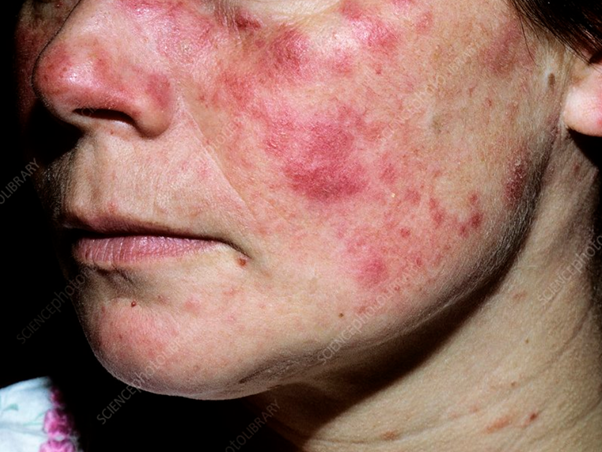Systemic Lupus Erythematosus
Systemic Lupus Erythematosus (SLE), commonly known as lupus, is a chronic autoimmune disease classified among systemic connective tissue disorders. It can affect multiple organs and systems, including the skin, kidneys, joints, cardiovascular system, nervous system, and blood-forming (hematopoietic) system.
If untreated or poorly managed, SLE can lead to permanent and often multi-organ damage. The disease occurs much more frequently in women than in men. One of the hallmark early symptoms is a facial rash shaped like a butterfly across the cheeks and nose, which has become the symbol of lupus awareness.

Signs of Lupus
Lupus can affect many parts of the body, and its symptoms often appear gradually. Common symptoms to watch for include:
- Fatigue and general weakness
- Joint pain and swelling
- Butterfly-shaped facial rash across the cheeks and nose
- Fever without an obvious cause
- Hair loss (non-scarring alopecia)
- Mouth ulcers
- Sensitivity to sunlight (photosensitivity)
- Unexplained bruising or bleeding
Because these symptoms can overlap with other conditions, early recognition and medical evaluation are essential to prevent organ damage and improve long-term outcomes.
Causes and Risk Factors
The exact cause of lupus remains unknown, but research shows it develops in genetically predisposed individuals when combined with environmental or biological triggers. These may include:
- Infections
- Hormonal factors (estrogen plays a role in the higher prevalence among women)
- Medications (drug-induced lupus)
- Environmental triggers such as ultraviolet (UV) radiation
Lupus is not directly inherited, but genetic susceptibility increases the risk, especially if there is a family history of autoimmune disease.
Why Early Diagnosis Matters
Because lupus has a wide range of symptoms and can mimic other conditions, diagnosis is often delayed. However, delayed diagnosis worsens prognosis and makes long-term remission more difficult to achieve. Early recognition and treatment are crucial to:
- Prevent irreversible organ damage
- Improve quality of life
- Reduce disease flares and hospitalizations
- Prolong survival
Diagnosis
In clinical practice, physicians use the 2019 EULAR/ACR classification criteria. Diagnosis requires:
- Positive antinuclear antibodies (ANA) > 1:80 on Hep-2 cells (necessary for classification)
- A score of at least 10 points, based on a combination of clinical and immunological criteria
Clinical Criteria Include:
- Fever above 38.3°C
- Non-scarring hair loss (alopecia)
- Oral ulcers
- Seizures, psychosis, or delirium
- Acute pericarditis or pleural effusion
- Low platelet (thrombocytopenia) or white blood cell count (leukopenia)
- Kidney involvement (proteinuria > 0.5 g/day)
Importantly, these symptoms do not need to appear at the same time — they can occur at different stages of the disease.
While classification criteria guide diagnosis, Lupus can sometimes be confirmed clinically even if all criteria are not met, reflecting the disease’s complex and variable presentation.
Treatment of Lupus
SLE requires multidisciplinary care, with treatment focused on survival, organ protection, flare prevention, and quality of life.
Standard Approaches:
- Antimalarial agents for most patients without contraindications
- Glucocorticosteroids to control inflammation and disease activity
- Immunosuppressive and cytotoxic agents, used depending on severity and organ involvement
Treatment Goals:
- Intensive immunosuppressive therapy in early disease to prevent irreversible damage
- Long-term management to reduce relapses
- Treatment of comorbidities (hypertension, infections, anemia, diabetes, myositis), which are common in SLE patients
Epidemiology
The global incidence of systemic lupus erythematosus is estimated at 0.5 to 30 cases per 100,000 people per year, with higher prevalence in women of childbearing age. Improved recognition of mild forms has led to rising diagnosis rates worldwide.
